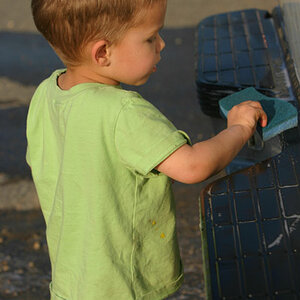TheForestMan
TPF Noob!
- Joined
- Oct 25, 2011
- Messages
- 12
- Reaction score
- 0
- Location
- Hong Kong
- Website
- www.downtown-metropolis.com
- Can others edit my Photos
- Photos NOT OK to edit
Hi There!
Here goes the story of a newbie to darkrooms... yesterday, I decided to process one of the Pan F+ I shot last weekend, only to find out with horror that it was filled with dark dots all over the place. Therefore, in desperation and before I decide to process the other rolls of Pan F I shot, I am begging for your advice and wish anyone can identify what went wrong.
Background story and details of the processing:
I processed T-Max 400 before and never had a problem (therefore I am not 100% newbie... but still am not sure what I am doing sometime)
For this roll, I processed with the following chemicals and process:
Processing for EI 50 (no push/pull)
Prewash: tapwater for 2 min
Developper: D-76(stock) at 22c for 5:30 min
Stop Bath: Ilfostop at 22c for 1:00 min
Fixer: Ilford RapidFixer at 22c for 5:00 min
Hypo clearing agent: Kodak at 22c for 2:00 min
Rinsing: tapwater for 5:30 min
PhotoFlo: Kodak PhotoFlo 200 for 1 min with tapwater
agitation for developper: 1 min roll and inversions, 10 seconds every min afterwards
The fineprint and suspect : The tap water?
I live in Hong Kong, and the tapwater is not the best and quite hard and is now at 27c without heating.
I believe I made a newbie mistake in handling the whole operation. I did the prewash before I cooled down the chemicals to 22c and therefore, the development tank was left with the dry film inside for about 10 min on the side of the sink (I use one sink for the whole draining/cooling, etc... apartments in Hong Kong are small... not a lot of sinks ).
).
I suspect the water is so hard here that some chemicals in the tap water started the development of the film way before I poured the D-76 in the tank.
This is all newbie mistake but I would like to know if my assumption above is correct and if I can safely proceed without prewash for the other rolls of Pan F+
Now if I am totally wrong with the above assumption, here are some details about the pic itself:
Exposure time: 4 mins (taking into account reciprocity failure)
taken at night with some annoying stay light and no lens hood on my planar 80mm (on hasselblad 503 CXi - irrelevant here but some may ask :0)
Is it too long for the Pan F+ to handle (I doubt it and am sure it is the development that went wrong but I never know).
Here is the picture scanned: advert your eyes... it hurts... :0)
Note that it looks like snow... in Hong Kong it would a first :0)

Hope you guys an help me pinpoint the problem here.
Thanks in advance!
Here goes the story of a newbie to darkrooms... yesterday, I decided to process one of the Pan F+ I shot last weekend, only to find out with horror that it was filled with dark dots all over the place. Therefore, in desperation and before I decide to process the other rolls of Pan F I shot, I am begging for your advice and wish anyone can identify what went wrong.
Background story and details of the processing:
I processed T-Max 400 before and never had a problem (therefore I am not 100% newbie... but still am not sure what I am doing sometime)
For this roll, I processed with the following chemicals and process:
Processing for EI 50 (no push/pull)
Prewash: tapwater for 2 min
Developper: D-76(stock) at 22c for 5:30 min
Stop Bath: Ilfostop at 22c for 1:00 min
Fixer: Ilford RapidFixer at 22c for 5:00 min
Hypo clearing agent: Kodak at 22c for 2:00 min
Rinsing: tapwater for 5:30 min
PhotoFlo: Kodak PhotoFlo 200 for 1 min with tapwater
agitation for developper: 1 min roll and inversions, 10 seconds every min afterwards
The fineprint and suspect : The tap water?
I live in Hong Kong, and the tapwater is not the best and quite hard and is now at 27c without heating.
I believe I made a newbie mistake in handling the whole operation. I did the prewash before I cooled down the chemicals to 22c and therefore, the development tank was left with the dry film inside for about 10 min on the side of the sink (I use one sink for the whole draining/cooling, etc... apartments in Hong Kong are small... not a lot of sinks
I suspect the water is so hard here that some chemicals in the tap water started the development of the film way before I poured the D-76 in the tank.
This is all newbie mistake but I would like to know if my assumption above is correct and if I can safely proceed without prewash for the other rolls of Pan F+
Now if I am totally wrong with the above assumption, here are some details about the pic itself:
Exposure time: 4 mins (taking into account reciprocity failure)
taken at night with some annoying stay light and no lens hood on my planar 80mm (on hasselblad 503 CXi - irrelevant here but some may ask :0)
Is it too long for the Pan F+ to handle (I doubt it and am sure it is the development that went wrong but I never know).
Here is the picture scanned: advert your eyes... it hurts... :0)
Note that it looks like snow... in Hong Kong it would a first :0)

Hope you guys an help me pinpoint the problem here.
Thanks in advance!


![[No title]](/data/xfmg/thumbnail/37/37622-530e264cdd98e6648079b89d7d3cd356.jpg?1619738153)

![[No title]](/data/xfmg/thumbnail/34/34061-e097813b3719866d07ff3e78e8119ffa.jpg?1619736258)

![[No title]](/data/xfmg/thumbnail/36/36663-6033a8e60c3aec9731283de0f7f2aafb.jpg?1619737676)


![[No title]](/data/xfmg/thumbnail/37/37621-b86590cf53fc4001d12701ee3091029b.jpg?1619738152)
![[No title]](/data/xfmg/thumbnail/32/32983-e979bc0c64090f2693d7fae6b3cc425c.jpg?1619735813)


![[No title]](/data/xfmg/thumbnail/37/37625-7e132688457d56e50320a8c99a79fe38.jpg?1619738154)